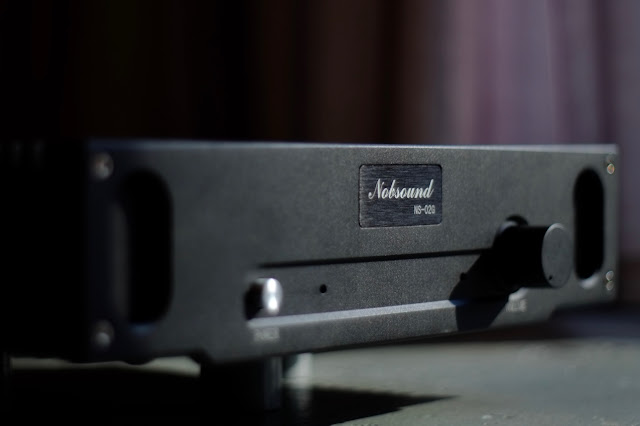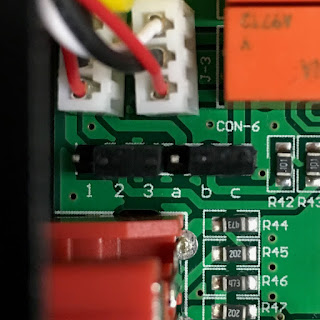 |
| Original JLH1969 Class A amp schematic |
The John Linsley-Hood 1969 Class A amplifier circuit is a classic solid state design that is carefully studied by audio designers. Even the great Nelson Pass revisited this circuit when he embarked on low wattage amplifier designs.
It has been described as one of the most tube sounding solid state amplifier designs, which is not surprising since John Linsley-Hood's references were tube amplifiers. Here's a link to the 1969 article published by Wireless World.
Since I am a DIYer at heart, I originally considered buying a pair of these circuit boards on eBay. But when I spotted a built unit for $170/shipped, I calculated that by the time I factored in the cost of a power transformer and a massive heat sinked chassis, it didn't seem wise or cost effective to go the DIY route.
The JLH 1969 Class A clone I got is branded Nobsound NS-02g but I've seen the same chassis and guts in silver or gold sporting a Krell logo!
It is very compact- a hair over 13" wide x 8.25" deep and 3" high- but it weighs 12 lbs. due to the heavy gauge chassis, massive heatsinks and power transformer. Parts quality is surprising for a $200 amplifier requiring discrete components. Input impedance is set by an Alps Blue Velvet 10k Ohm logarithmic potentiometer. There are no IC chips in this amp, just a couple pairs of transistors, a handful of resistors and capacitors + a lot of copper wire wound in the toroidal transformer. This is a true Class A design from the late 60s built at the end of the second decade of the 21st century.
When I first fired up the amplifier, I heard a buzz when the input level control was at maximum. I traced this to the IEC socket which was not grounded. Strapping the center pin (green cloth insulated wire) to ground took care of the buzz.
!!!WARNING!!!
The voltages in this circuit are potentially lethal! Proceed at your own risk!
Set Up and Adjustments
 |
| NOTE: Red probe to test point, black probe to chassis ground |
Idle Current
Out of the box, the amp sounded pleasant but I was not hearing anything magical. I was suspicious of the meager 0.5 amp AC current draw at 120V I monitored on my GenRad Variac. So removed the top cover to study the circuit and determine the purpose of the two potentiometers on each channel's PC board.
The pot towards the middle of the PC board is for idle current adjustment. Since I didn't have a manual and couldn't find one on-line, I took the cue from this video by a JLH 1969 Class A kit amp builder.👍 His circuit board looked similar enough, thus, the proper voltage must be closer to about 20V(?). I measured 26.5V and 26.2V on my unit. So I turned the pot clockwise until I got about 24 volts DC on both channels. The AC current draw was now over 1 amp and I started feeling heat emanating from the chassis.
AC Balance
The next step was to adjust AC balance. I loaded each channel's output with an 8 ohm, 20W wire wound resistor and then injected a 1 kHz sine wave at the input jacks. I adjusted the AC balance pots on both channels while observing the clipping behavior closely for best symmetry - both phases of the trace should "square off" simultaneously.
Tweaking the idle current
 |
| 137℉ @ the heatsink |
I checked the idle current once more and listened. 26V yielded almost 10 watts per channel on the bench but I felt the sound can be sweeter. At 21.5V the amp sounded excellent. But the chassis was running physically too hot. Just to be conservative, I backed off a bit and actually found the sweet spot between 22V - 24V. I also made sure there's always ample ventilation around the amp.
On the Test Bench
Top trace = signal generator
Bottom trace = amp output
 |
| 100Hz |
 |
| 1kHz |
 |
| 10kHz |
Not perfect, but nice and clean square waves from a half a century old solid-state design
Input sensitivity = .25 Vrms > ~ 6.8 watts per channel rms into an 8 ohm load with both channels driven
Tweaks
A slight glare in the upper midrange was ameliorated when I by-passed the 2.2uf input capacitors with 0.47uf Vitamin Q "Hyrel" PIOs and the 2500uf output capacitors with 10uf KBGs. Before reassembly, I also replaced the red LED pilot lights with blue LEDs. Much easier on the eyes especially in a dimly lit room.
The Nobsound clone amp spent most of its time in the system above, driving a pair of Altec 755Cs in 618 cabinets and also a pair of moderately efficient Radio Shack LX4s. I also listened to it in the main system driving the Altec 2-way. In both cases it never failed to sound sweet, fatigue-free, with a tube-like quality and depth in the midrange, maybe not the tightest bass but definition was good + airy highs.
The only time it betrayed its solid-state identity was when I spun an LP of Shostakovich Symphony No. 11 in the main system. It went into nasty clipping during orchestral peaks like a typical solid-state amp. Maybe it was asking too much from a Class A amp with a measly 7 watts rms per side to cope with the 16 ohm load presented by the Altec 2-way? However, with the same piece and on the same speaker system, my 4 watt per channel Stereo SE2A3dx with Tango NY15s went into overload with grace and composure at a similar SPL.
It is a testament to John Linsley-Hood's engineering and hearing abilities that his 50-year-old circuit is still a very capable music maker. Even if it can't replace any of the tube amplifiers in my collection, this is a much more listenable amplifier than the handful of contemporary Class D switching amps I've heard thus far.














































